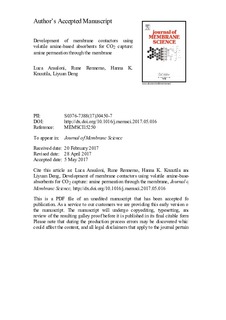| dc.contributor.author | Ansaloni, Luca | |
| dc.contributor.author | Rennemo, Rune | |
| dc.contributor.author | Knuutila, Hanna K | |
| dc.contributor.author | Deng, Liyuan | |
| dc.date.accessioned | 2017-10-26T07:00:49Z | |
| dc.date.available | 2017-10-26T07:00:49Z | |
| dc.date.created | 2017-05-15T10:31:33Z | |
| dc.date.issued | 2017 | |
| dc.identifier.citation | Journal of Membrane Science. 2017, 537 272-282. | nb_NO |
| dc.identifier.issn | 0376-7388 | |
| dc.identifier.uri | http://hdl.handle.net/11250/2462230 | |
| dc.description.abstract | Non-porous membrane contactor offers the possibility to reduce the amine emissions if the membrane layer is specifically designed to act as a barrier for the amine transport. In the present paper, the amine permeation through an AF2400 self-standing membrane, previously identified as the best dense layer material, have been investigated to evaluate the amine-emission preventing capacity of the membrane for the first time. The transport properties of different amine-based aqueous solutions (monoethanolamine, 3-methylaminopropylamine and diethylethanolamine) through a 10µm-thick self-standing AF2400 membrane have been characterized through pervaporation experiments in a temperature range of a typical amine absorption step (25 – 60 ºC). Humid CO2 permeation tests were also carried out to simulate the real gas membrane absorption separation conditions. A limited decrease (up to 25%) of the CO2 permeability was observed from dry state to fully humidified conditions, suggesting that the membrane contactor can be operated with humid flue gas to prevent solvent dehydration. The amine fluxes were found at least two orders of magnitude lower compared with CO2, demonstrating the ability of the membrane to favor the transport of CO2 over the amines. | nb_NO |
| dc.language.iso | eng | nb_NO |
| dc.publisher | Elsevier | nb_NO |
| dc.rights | Attribution-NonCommercial-NoDerivatives 4.0 Internasjonal | * |
| dc.rights.uri | http://creativecommons.org/licenses/by-nc-nd/4.0/deed.no | * |
| dc.title | Development of membrane contactors using volatile amine-based absorbents for CO2 capture: amine permeation through the membrane | nb_NO |
| dc.type | Journal article | nb_NO |
| dc.type | Peer reviewed | nb_NO |
| dc.description.version | acceptedVersion | nb_NO |
| dc.source.pagenumber | 272-282 | nb_NO |
| dc.source.volume | 537 | nb_NO |
| dc.source.journal | Journal of Membrane Science | nb_NO |
| dc.identifier.doi | 10.1016/j.memsci.2017.05.016 | |
| dc.identifier.cristin | 1470183 | |
| dc.relation.project | Norges forskningsråd: 239789 | nb_NO |
| dc.description.localcode | © 2017. This is the authors’ accepted and refereed manuscript to the article. LOCKED until 8.5.2019 due to copyright restrictions. This manuscript version is made available under the CC-BY-NC-ND 4.0 license http://creativecommons.org/licenses/by-nc-nd/4.0/ | nb_NO |
| cristin.unitcode | 194,66,30,0 | |
| cristin.unitname | Institutt for kjemisk prosessteknologi | |
| cristin.ispublished | true | |
| cristin.fulltext | original | |
| cristin.qualitycode | 2 | |

